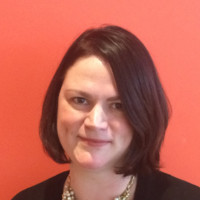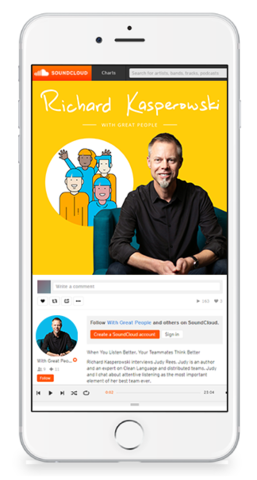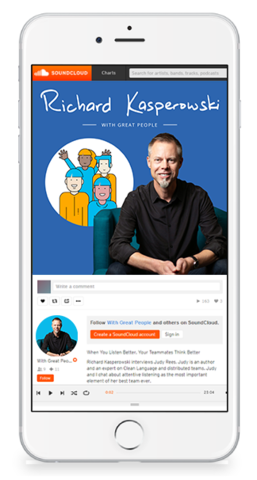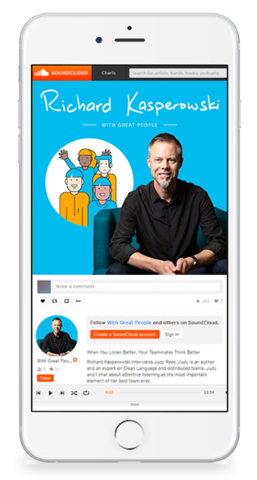Categories
Kate O’Brien: How “Rushing to Health” Actually Makes Your Team Perform Worse
It is a part of human behavior to resist change, especially when things seem to go well. So, how do we secure “buy-in” among the stakeholders for the new ideas? In this episode, Richard interviews Kate O’Brien, Senior Human Resources Director at Remix Therapeutics and an expert on people analytics. She tells us how the teams assume ownership over their work, outcomes, and, yes, changes that affect their work.
When you finish listening to the episode, connect with Kate on LinkedIn.
Watch video
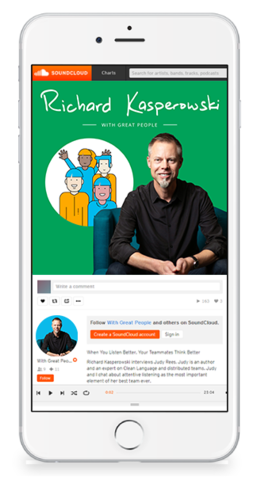
Listen Audio
Kate O’Brien: How “Rushing to Health” Actually Makes Your Team Perform Worse
with Kate O’Brien
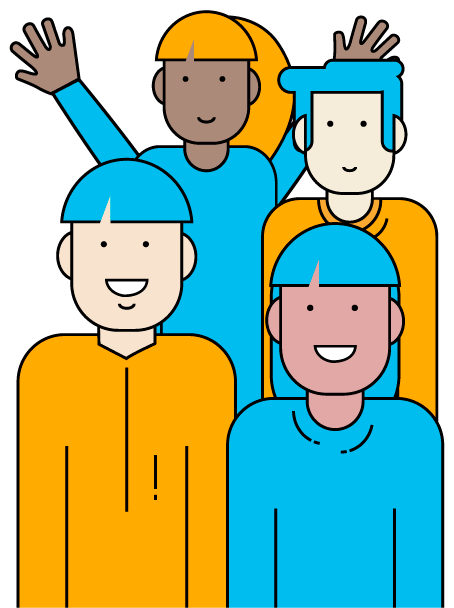
TRANSCRIPT
Richard:
Hi, friends, and welcome back to “With Great People.” The podcast for high performance teams. I’m Richard Kasperowski. Our special guest today is Kate O’Brien. Kate is senior director of human resources at Remix Therapeutics, and she’s an expert on people analytics, which is a really interesting topic to me. To support this podcast, visit my website, kasperowski.com.
Richard:
Hey, Kate. It’s so nice to see you again.
Kate:
So good to see you, we haven’t talked in a while.
Richard:
Yeah. Is there anything else we could add on to that intro?
Kate:
No, I think it’s good.
Richard:
Alright. Let’s see, so we got to know each other… It’s in your LinkedIn profile, we can talk about anything that’s on your LinkedIn profile. It’s all out there. We met while we were both working with Broad Institute and you introduced me to this field of people analytics. I’m really grateful for that. I learned a lot working with you there.
Kate:
Yeah, I remember it was about six years ago and you were working with the software engineering platform on Agile, which I was familiar. I had heard of it, but I’d never really seen it in action. And as that team was growing, I was working on some team effectiveness and it was just a natural melding. And I think we were both excited about what the other was bringing to the table.
Richard:
Yeah, and I’ve always been really interested in team effectiveness and you helped me understand ways to actually measure it and make it quantitative.
Kate:
It makes it… I learned this years ago. If you can measure team effectiveness, it makes it easier to define what team effectiveness looks like and it makes it harder for teams to do what I call rushing to health, which is saying, “Oh, everything is great, we all get along great, everything is fine”, when you know that it is not. So, when you have anonymous scores from the team, it makes it much easier to facilitate a conversation about what’s really going on.
Richard:
Oh, that’s so cool. And I love that phrase, rushing into health, which is really like faking that we’re healthy.
Kate:
Yeah, I learned that from a consultant years ago. It’s so common, you know, and I’m in the HR field now, but it’s so common. For instance, if there’s a conflict between a manager and an employee or, you know, I have instances where people are in performance improvement plans and every 60 days we all have to touch in and I have to be there as the HR person. And, you know, it can be awkward for everyone, but I’m always struck at how it got to the point that the person’s on a performance improvement plan. We legitimately hope this person can improve, ’cause we would like to retain them. And how often the managers back away from really having that conversation, even now that they’re on a performance improvement plan of what the manager needs from the employee to improve in real specifically about how things are going. I find a lot of times managers will say, “Oh, it’s all fine now, it’s all good.” And they just want this process to go away, but they’re not really talking about the issues. It’s almost harder for the managers than it is for the employees themselves.
Richard:
Yeah, yeah. And that whole performance improvement plan thing, it’s… The look on your face. Yeah, it’s rough. As a manager, I’ve done it with people. Boy, I don’t know.
Kate:
Yeah, it’s interesting too ’cause I’ve gotten very involved in the last few years about thinking about… Instead of performance management, which typically when employees hear you talk about performance management time, the grown and I’ve really pushed away and run a lot of pilots to see what happens. What if we’re actually focusing on performance feedback about how are things going? You know, what do you want to do going forward? How can you build those skills? Actually be a growth mindset. There may be some things that you’re not good at, but you’re not good at them yet. And what happens a lot with performance management systems is, it’s actually designed to root out the few people who are a performance problem and everyone else suffers through that process. So, a big thing that I have really pushed in recent years is, separate performance improvement or performance problems from the feedback process, so that it’s really about growth for most people. And then if there’s a performance issue, you know, there’s a process for that. There’s an awkward conversation, but don’t make everyone suffer through this process that people don’t find valuable when you’re really solving the few people who are performance problems. Just go deal with that.
Richard:
Yeah, yeah. Alright, let’s talk about teams. We’re both… We both geek out on teams and team performance and team health and all these things. I want to know about the best team you have been a member of, and what was that like for you and I want to know all about it. So, actually, I’m curious to hear how you define team. How do you define the word “team”?
Kate:
You know, it’s funny. I was actually looking that up today, the difference between a team and a group for something I’m working on with a team right now in my current job. But, you know, for a team to actually be a team, it needs to be a group of people who have a shared goal and also have integrated tasks. Like they rely on each other to get work done. They cannot be solely in a silo.
Richard:
Okay, I love that. I usually forget that part. They need to have integrated tasks.
Kate:
Right, ’cause sometimes I’ve realized… I’ve done team effectiveness interventions only to realize, “Oh this actually isn’t a team. It’s a group of people who happen to be under a heading”, but there isn’t really team dysfunction ’cause they’re not actually a team.
Richard:
Oh, so interesting.
Kate:
Right, like if…
Richard:
If they were a team, you would call team dysfunction, but they’re not a team, so we can’t call it that.
Kate:
It’s just people sitting next to each other that perhaps don’t care for one another.
Richard:
What is this team’s dysfunction? Well, it’s that they’re not a team.
Kate:
Exactly. But there are instances where they’re not a team and they don’t need to be a team.
Richard:
Yeah.
Kate:
Yeah.
Richard:
Yeah, alright. Alright, so that definition. What’s the best one of those you’ve ever been a member of in your life? And this could be a work team or not a work team, like any group of people with a common goal and integrated activities. I’ll say activities, so it doesn’t sound like it’s work.
Kate:
So, I wasn’t always in human resources. I joined human resources about six and a half years ago and I had a lot of different jobs, but gosh, probably 10 years ago now I was working in healthcare. I was part of a primary care senior leadership team. And you know, this hospital had like 26 primary care practices. And there was a project that came up that I was tangentially involved in, but got really involved in because it was just such a cool thing they were trying to do. Basically, there was… A lot of times in healthcare systems, the referral management system is not automated. And so, to explain what that is, it is when a patient comes in to see their primary care doctor and the primary care doctor realizes, “You know, you may have a heart condition. I want you to go see this cardiologist”. And the patient gets a piece of paper and is supposed to schedule that appointment. Well, sometimes that happens and sometimes that doesn’t and a lot of people need their hand held. You know, they’re not sure how to get through the phone line or English is not their first language or that practice does not pick up the phone. You know, all kinds of things happen. So, this hospital system was purchasing this automated referral management system and what it would do was, the primary care doctor would put the referral in the front desk and that practice had to fill out some information about the patient. It would then go to the specialty practice that was getting the referral. And there would be guidelines of how many days they had to call that patient, schedule it. And there were actually check systems to see whether it happened. When the system was introduced, there was a physician leader leading this and the argument they were making to people… You know, no one has to do anything. So, a big part with a successful implementation is for people to understand the why and see benefit in it for them. And the why that this physician leader was pitching and stressing was that the primary care physicians got a small bonus every year, depending on hitting certain metrics. And one of the metrics that was going to be counted was the percentage of referrals that they had going through the system. The reason the hospital system wanted people to be using the referral management system is, by using that, they made sure that their primary care doctors were referring patients to doctors in their network, so that hospital system continued to get a revenue stream. We did not want patients leaving that system because then they wouldn’t get the revenue stream. That is not an exciting argument to doctors who are doctors because they want to get their patients the best care, and is not exciting to the people in the front desk who actually are the most critical people to see if this happens because they’re not getting that bonus. And in many cases, you know, they are the working poor. So to hear, “Oh, so happy this doctor’s going to get this bonus.” And also, for the effort that everyone would have to go through to adopt the system, you know, it would only translate to maybe $1,000 for that doctor. So, if you didn’t feel particularly drawn to the notion that your hospital system would get more revenue, if that didn’t sing to your heart, it wasn’t going to be successful. So, the job I had at the time, I was kind of like an internal consultant and I could pick and choose what I was going to work on. And I realized it had an amazing value proposition, which is the following. If people used that system, they were able to make sure their patients got the care they needed and they didn’t fall through the cracks. And the people at the front desk love the patients. They find huge meaning and purpose in their work. And the doctors find huge meaning and purpose in their work. And so, the value proposition is not, you know, make more revenue for the hospital. The value proposition is, if you use the system, we know that your patients will get that follow-up care and will see the cardiologist before they have a heart attack or some other horrible outcome. And that is what captured the hearts and minds.
Richard:
Yeah.
Kate:
So, this very long winded with this team, so there was a central project manager from the physician’s organization that was going to be running this. And so, the kind of job I had, I could kind of pick and choose what I wanted to work on. And I realized, for the success of this referral management system, you had to get primary care using it and adopting it because they’re the ones who make the referrals to specialty. So, if you don’t start and get that buy-in there, the system fails at the get-go. So, I reached out to this project manager and explained, “You know, we need to change the value proposition.” And I had invited them, I did some kickoff meetings and I had this junior project manager with me who was just fabulous and just, you know, really thought her job was meaningful too, which it was, but I set up these meet and greet conversations and the primary care practices and described what the system… Well, actually, I didn’t even describe what the system did. I started with an open-ended question and it was practice managers, it was the front desk people, it was some doctors and asked the question, “You know, what’s the struggle right now with referral management in getting sick patients to see the specialists they need to see?” Everyone had a laundry list of things they worried about, things that fell through the cracks. And I could then say, “Okay, what if we have a system we could all implement, but it would take work from us and it would meet some of these needs but not all of them?” Everyone leaned in.
Richard:
Aha. And then, I showed the system and I listed. I was like, there are some things the system does not do that was going to take extra work around from the front desk. And in doing these conversations, the front desk was like, “I’d be happy to do double entry in this system and the other system we have, if it means Mrs. so-and-so will get into this doctor and I know she’s taken care of because I worry about her.” Yeah.
Kate:
So, we did that with all 14 practices and the project manager who was leading this project and the junior person I had on my team. The project manager suddenly realized, “Oh, she’s going to be fabulously successful if we all partner and lean in.” And so, what we did was, I created the training for how to integrate. Actually, not even the training. It was how to integrate the system into the workflows in the primary care practice. And we did these process maps, you know, post-its with the front desk and the medical assistants, because they’re actually the ones who tell the doctors what to do. Not from a medical standpoint, but they’re like, “You need to check off this box, you need to do this thing.” They make sure that all happens. So the doctors actually weren’t key for the buy-in. The doctors just needed it to be easy. The people who needed the buy-in were the medical assistants, the LPNs and the front desk ’cause they’re the ones who needed to do outreach, needed to do double entry on some systems, ’cause it wasn’t like a seamless tool. Phenomenally successful.
Kate:
And I loved the people that I worked with, developed a great relationship with that project manager because she also cared about the patients, but she realized, “Oh my God, this is the value proposition.” What was really great on Go-Live Day, we had three practices at a time go live and we didn’t make them. We asked for some volunteers, and as soon as other practices realized what the system did and that patients were getting better care, everyone wanted in, so we created demand. And our goal, you know, unofficially was, we had this one particularly huge medical practice where all the residents work and our mantra was, break the system with… It was called Gen Center with the Gen Center, ’cause the volume would be so high. They wanted the hospital to see, this is how many referrals and business we keep within this system. But in exchange, the specialty practices have to do their job to figure out how to get these patients in.
Richard:
Right.
Kate:
And so, it was… I think it resulted in millions of dollars of revenue, and leadership was incredibly happy, but the thing that the hospital and the people who worked there loved, it was the care for the patients and that’s what mattered and why it worked.
Richard:
Yeah.
Kate:
And it was a blast.
Richard:
Alright. So, the team you’re defining here is you, this project manager, this junior project manager?
Kate:
Yep, it was us and then every practice has a practice manager, a medical director. So, we had to develop a partnership and pull all of them in for support because they had to let us into the practices, we had to find… You know, in every practice, there’s an LPN or an MA who just is that connector and can see the vision and can rally everyone else. So, it was really… You know, all told how many people were responsible for this being successful. Probably 75, but it was, how do you… You know, but it was like 14 different teams and how do we roll it out and make it, pull them in, give them the ownership, make sure that we are implementing this in a way that works for them. Yeah, it was a complicated rollout that was actually incredibly easy because people wanted it.
Richard:
Alright, that’s really important because people wanted it. So you’ve been taking yourself back to this team. I’ve been… I feel like I went on this trip with you back to this team and the whole story about the project and how it happened. If you could look within yourself and summarize the sensation of that whole experience in one word, that best… It’s a work team. The best work team, the best team that you’ve ever been a part of. What one word would you use to describe it?
Kate:
Joyful.
Richard:
Joyful.
Kate:
Joyful.
Richard:
Alright. And how is it joyful? What about joyful?
Kate:
Healthcare is hard to work in. The systems are hard, the hours aren’t great, patients are cranky. You know, our health system in America is very disjointed and hard to navigate. It was joyful because we all had a shared commitment and love that for this one time, all these patients would have an easy way to see the specialists they needed to see. And it didn’t matter your socioeconomic status, it didn’t matter your immigration status, the language you had, that everyone would get taken care of. And that’s a huge commitment. You know, that’s why so many people are in healthcare, but also the people who work in the front desk and things, a lot of them are from more marginalized communities. They saw a way to help their people.
Richard:
Aha.
Kate:
That’s joyful.
Richard:
Yes. Yeah, alright. Now, you know this is a great team. How do you know this is a great team? Are there other subjective senses that this was such an amazing group?
Kate:
Yeah, I mean, if you want to look at… You’ve got lead indicators and then I’d say like lag indicators, the ultimate outcome. The lag indicators I suggested to the project manager and these were suggestions I made because it was her project. I just saw my job was to bring primary care to the table. But the lag indicators we identified, it would be a number of referrals compared to previous years, ’cause if there’s a lot more staying internally, that means you’re keeping them within the network revenue obviously. And another one would be liability claims, malpractice insurance. So, those are business outcome measures. But the lead ones, it would be like for me in meetings when I was first introducing this to teams. Did they lean in physically? Like you can tell when teams are starting to get the idea and getting excited about it, they literally lean in or, you know, I had a flip chart. I demoed the system and I had a flip chart and said, “What are all the horrible things about IT systems you have to deal with?” And then I demoed the system and I said, “Our system has some of these horrible things. You’re going to manually have to work around these.” You know, it may not be worth it. Every single time someone would say, “Oh, I’m willing to do that if my patients get in.” And that was the front desk people. Every single 16 practices, multiple people, the doctors would be like, “I’m on board.” That’s that lean in. That’s an indication that you have it because they’re willing to put up with… It was a system that was not integrated into the main system, so you had to do double entry for everything.
Richard:
Yeah. It was going to be more work for some people.So, this idea of leaning in is both the physically leaning toward each other while you’re talking and it’s like doing extra work that might be hard or annoying.
Kate:
Yeah, and I didn’t go in. You know, a lot of times they always make systems sound like they’re the panacea for everything. Systems are never the panacea for everything, ’cause I’ve done a lot of IT systems. You know it’s bad when everyone is talking about, “Well, in the future, this goes away.” Some things go away, but not everything. And so, people are always disappointed. I wanted them to be eyes wide open from the get-go of what was going to be better and what was going to be worse because then they weren’t surprised by it. And they’re like, “Oh yeah, we knew that was coming,” but it’s worth it because and they’re coming up with the workarounds.
Richard:
Alright. Okay, and you’ve shared some the concrete steps in actions you took. Are there any other concrete behaviors that went into this being so successful?
Kate:
Yeah, I mean, I have a lot of experience in change management. So, I was kind of the mastermind behind this, but I think one of the biggest things is, since we rolled it out over time, I had a more junior project manager who’s really talented. You know, those people, you need to give them the space to do it and explain it’s okay to make a mistake. You got to get up and talk with marbles in your mouth until they’re no longer there. You know, we had 16 implementations to do. I was pregnant with my first child and I knew for the final two, which were the biggest practices, very complicated, I was probably going to be out of commission. It really was close with the date. So all along, it was having this person with me and having this central project management team with me and to really understand I had it all written out of how I’m doing the change management, how I’m getting kind of the hearts and minds, always with the idea of, you know, “Julie, you’re taking this over, you’re going to take this over.” And I think the biggest sign of success, I gave birth and was out a commission for the two biggest ones that went live. And no one noticed I wasn’t there, it was without a hitch. I was not the central player on Go-Live Day. It was all of them from the get-go.
Richard:
And I applaud you for that.
Kate:
Another thing is, I don’t like to do things more than once or twice, so I got through three implementations and knew it worked. And then I prefer to be behind the scenes and get the junior person up in front.
Richard:
Yeah, yeah. And I love that. Yeah, that whole way of… Well first, change management is kind of mysterious to me and the hearts and minds stuff is kind of mysterious to me. I’m like a “rights code knows logic” kind of person. Hearts and minds’s a little…
Kate:
It’s like, but where’s the hook that people care about? They don’t care about the hospital getting more revenue, they care about the patients, so we go with that.
Richard:
Yeah, and the ego-less way of leading, right?
Kate:
Yeah.
Richard:
It succeeded and you were back here.
Kate:
Right, right.
Richard:
In fact, you weren’t even there for the last two.
Kate:
Right, right. I’m Irish, it’s the great Irish exit. She’s gone and no one noticed. Yeah.
Richard:
That’s so cool. Now, okay, we’ve shared a lot already. What could listeners or viewers do to reproduce some of this success? Have their own best team ever.
Kate:
Yeah. I mean, selfishly, the reason… ‘Cause I opted in, no one asked me to be on this team, let alone deliver primary care. I’m the one who said, “You need primary care delivered.” The reason I jumped on it was, as soon as it was initially presented to me, I realized the hook was so obvious. The hook were the patients and I could see how those conversations would go. So, number one, with the change management project, don’t sign up for one unless you can find the hook. You know, when I was at Broad, we implemented Workday, which is an HR system and no one gets excited when a new HR system is coming into place. But, and I had to do the change management for that, I was okay doing it because I immediately saw the hook. Everyone hated the time entry system we had before that, so I didn’t focus on other things Workday did. I celebrated and we had a New Orleans style with a brass band funeral for the time management system. And that got everyone going, “What’s Workday?” And you got in and put in your time, you’re like, “That’s easier.” So, you got to find the hook.
Richard:
Alright.
Kate:
And find those junior people who are hungry to learn,
Richard:
Aha. Because, I mean, I just always… Everything I can share with them and give them the opportunity to practice and the safety to practice. And that opens me up to be trying new things and to wrap this up and move on to my next thing.
Kate:
Yeah. Cause I don’t want to do… There’s a huge difference between creating and implementing and maintaining. I create, implement innovation, but I’m not interested in doing it multiple times. I’ll give it to someone else, so I can go learn something new.
Richard:
Yeah, yeah. That totally resonates with me as well.
Kate:
Right.
Richard:
Before we pressed record and even at the beginning of this recording, we were talking about different things and I made a note to myself about something I learned from you. The TCI, the Team Climate Inventory is such an easy way to get data about teams.
Kate:
I just did it last week.
Richard:
Oh really?
Kate:
I hadn’t done it in four years, I had to remember how. Yep, that’s like the best thing ever.
Richard:
Yeah. What else could we talk about? Is there anything else you want to add about the work you’re doing right now or anything you’ve been thinking about or absolutely anything that…
Kate:
Yeah, these aren’t fully formulated ideas. I mean, one of the things I learned in running people analytics in particular, ’cause I had a dear colleague who I worked closely with on my people analytics team and she went somewhere else. We discovered that the results at all companies are pretty much the same. Like you can run the exact same surveys and things and, you know, the things that matter to people, the drivers of what motivates people it’s the same. And we realized, “Oh, it’s ’cause people are the same.” So, some things I’m doing here. I mean, I work for Biotech, it’s a much smaller company. I am using what I learned, are the drivers of engagement and everything that we’re designing with our people programs and our culture. If it’s not touching on one of those drivers, then I’m not doing it. So, it goes back to…
Richard:
What are these drivers?
Kate:
So, the drivers, and you might hear different terms, but, if any listener wants to look up anything from Gallup, because they look at engagement data in mega. But, in terms of the drivers for why employees come to work, one definitely is sense of belonging, rewards, you know, overall rewards, benefit and pay. That’s not a key driver, it’s a factor. You know, you can have the highest benefits in pay and lose people, but it’s a driver. A new one that’s existed since COVID is workload. And it’s the idea of, is your workload sustainable? A sense of purpose that what you do is meaningful. And there’s a fifth one that I can never remember, but I have written down somewhere. So, you know, as we’re scaling our culture and training our managers and coming up with our total rewards programs or even just like the happy hours we have, we’re looking at these drivers and figuring out which ones are we hitting. And a lot of times, team offsite could hit three, but just actually be planful about that. And then it becomes much easier to decide what you’re not doing or what’s noise.
Richard:
You mentioned Gallup, you use the… They wrote this book. I don’t even know if it had author names on it. Gallup wrote this book that basically just shares the 12 questions.
Kate:
Oh, yeah, It’s Marcus Buckingham.
Richard:
Okay.
Kate:
Yeah. You know, it’s funny, I only saw those recently. Yeah, those 12 questions would work. It’s funny, I didn’t know about that when I was doing engagement at Broad. Yeah, those 12 questions really cover it. So, all these engagement tools that you have out there, you want to make sure that you get those 12 covered and you’re pretty good. You’re very good. I’ve learned, don’t ask one of those 12 questions if the company doesn’t want to act on it.
Richard:
Oh, yeah, that. ‘Cause then people get less engaged, less motivated.
Kate:
Yeah, there’s an expectation you’re going to do something and also there’s an element of messenger getting shot. If leadership is not ready to touch and look at something, do not introduce it. I have none at Broad, but I have a career limiting story about me thinking, “But look at this data, it’s exciting.”
Richard:
And to share it with people and they’re like, “Okay, and what’s management going to do about it?” And you’re like, “I don’t know.” They’re not doing anything about it, and you’re like, “You’re right.”
Kate:
Yeah, I was on an IT implementation. I was leading the change management for it. It was a $350,000,000 project. It’s the first time I used data to look at change management. And it’s a failed project that never gets spoken about at this organization. No one talked $350,000,000 just boom, gone. I had the data weeks in advance showing we were in trouble and I was so excited, ’cause I went to leadership and I explained this to them. And I said, “The great news is we have time to take action, but it’s going to be hard action to take.” No one spoke at the meeting and I laughed thinking, “I don’t understand, maybe I didn’t explain myself clearly.” And someone said, “No, you explained yourself very clearly.” They’re not interested in what you have to say to the point that 3 months later, it was a $350,000,000 failure. All of these executives kept their jobs, they shouldn’t have. So, a lot of times leaders don’t always want the data.
Richard:
Yeah, good to keep in mind. Make sure the leaders want whatever change or improvement is happening. You talked about opting in. Connecting with people’s hearts and minds seems to be the center stone, the foundation of change management?
Kate:
Yeah, and the big one too is, you know, leaders may say they want something, always pay attention to the behaviors, not the words.
Richard:
Yeah, okay.
Kate:
Because if the behaviors don’t match, you are set up for failure. I mean, you’re literally stuck ’cause you may have the best tools, but you can’t convince people of something that they understand, but they don’t want. I mean, you could liken it to, you know, election stolen. You know, mathematical responses is not going to satisfy that belief.
Richard:
Yeah, yeah, for sure. Is there a way for listeners to get in touch with you if they’d like to do that?
Kate:
Oh, sure, yeah. I’m on LinkedIn and I now head an HR, so very involved in recruiting and I’m actively on LinkedIn, so people can always reach out.
Richard:
Alright, super cool. Thanks for that. And we’ll put a link to the LinkedIn profile and the episode notes and that’s it. This has been a really fun half hour since we started recording.
Kate:
Yeah, no. Thank you so much for inviting me. This was great.
Richard:
Yeah, yeah, so great for me. I really love chatting with you. It’s so much fun, I learn something every time and I always smile and giggle.
Kate:
That’s always nice ’cause, you know, day to day is sometimes hard, so to know someone wants to listen and record it, I’m like, “I’m there.” Doesn’t always happen.
Richard:
Alright. And we’ll wrap this up the way I always do. Thanks, Kate, for joining us. Really appreciate it. And, listeners, remember to support this podcast. Just visit my website, kasperowski.com.
